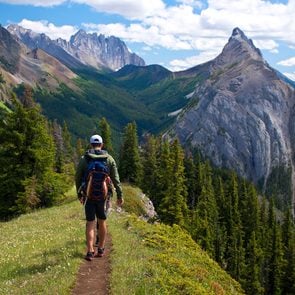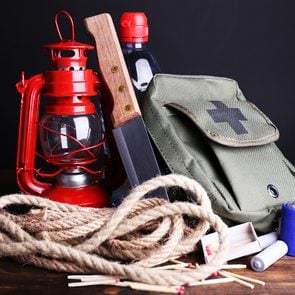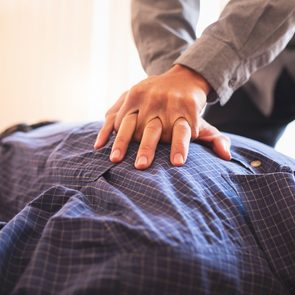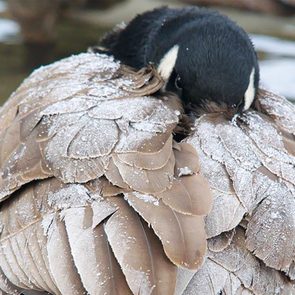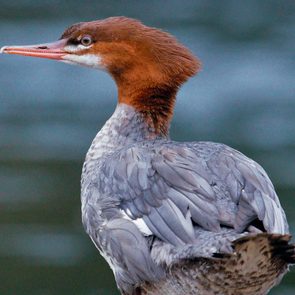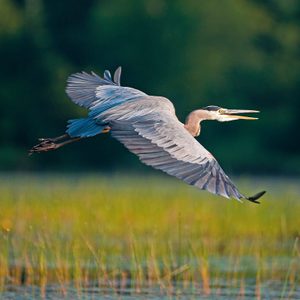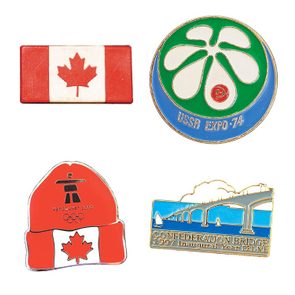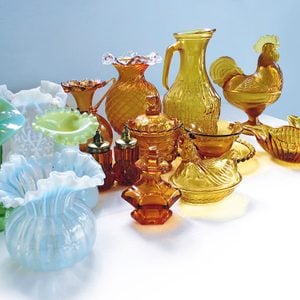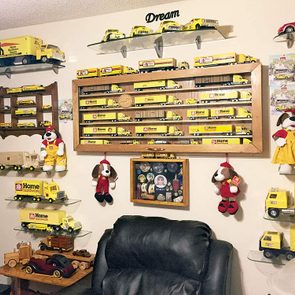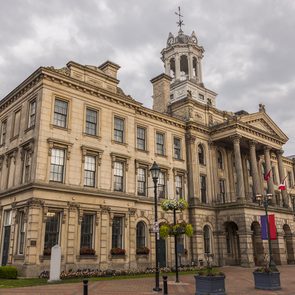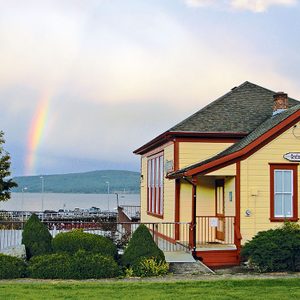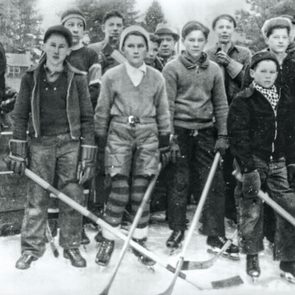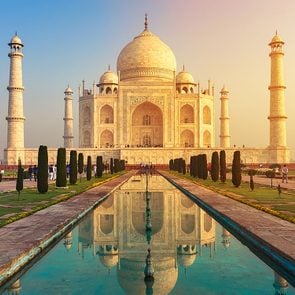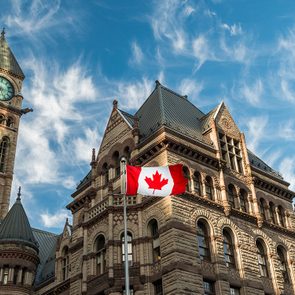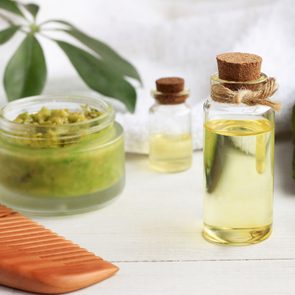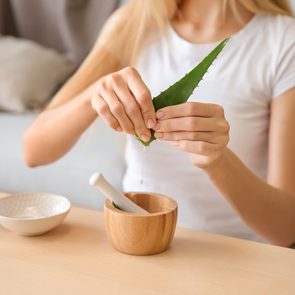
I Survived a Mudslide
Sheri Niemegeers, 47, an investment administrator
It was the Victoria Day long weekend in 2018 and my partner, Gabe Rosescu, and I were taking a road trip in his little Hyundai Elantra from my home in Weyburn, Saskatchewan, to visit friends in Nelson, B.C. We are both adventurous, and we couldn’t wait to go hiking and exploring. It was our first trip together, after six months of dating.
At around 5:30 p.m. on Thursday, May 17, we were driving about 18 kilometres west of Creston, B.C., on a steep mountain road known as the Crowsnest Highway. I was texting updates to my family and enjoying the view. We weren’t aware there’d recently been flooding in the area. When I looked up from my phone, I saw a wave of mud and an enormous tree barrelling down the mountain, right in front of the car. Gabe tried to brake, but it was too late.
I looked at Gabe and we both said, “Oh, shoot”—understatement of the century. The mudslide sent our car plummeting nearly 300 metres down a rocky cliff. It landed on its side in a group of trees.
I don’t know how long we were unconscious, but I woke up to the sound of Gabe moaning. He was slumped over the steering wheel, and there was blood everywhere. Outside my passenger window there was a steep drop. Every time I moved, I was hit with excruciating chest pain. I had broken my sternum, and my right ankle was smashed and practically turned backward. Gabe, meanwhile, had broken his orbital bone, nasal and cheek bones. Parts of his skull were crushed and his vision was damaged. But the body is an amazing thing, and somehow we were both able to crawl out of that wreckage.
I was so focused on our survival that I didn’t register the wrecked state of the car or where we were. We had no phone signal, so all we could think to do was yell for help. But my chest hurt too much to even breathe. So Gabe started shouting as loud as he could.
We were shocked when, after just a few minutes, we heard someone call back. Four bystanders had spotted us and waded through waist-deep mud to our rescue. I couldn’t walk, so the men took turns shimmying me up the rock face and helping Gabe make his way up to the road. Gabe was in shock, slipping in and out of consciousness, and I honestly didn’t think he was going to make it. When the EMTs finally got to us, they let us kiss goodbye from our stretchers as they loaded us into separate ambulances. I was swearing a lot as they took us away—I didn’t think I’d ever see my boyfriend again.
They took me to the closest hospital, in Trail, B.C., and Gabe was airlifted to the trauma hospital in Kelowna. All along the way, they kept shocking him to keep him awake. I was in the hospital for a week and a half, but they kept Gabe for six weeks. My surgeon had to reconnect the main artery in my foot, and Gabe’s had to split open his scalp three ways to reattach everything. Even after surgery, I’ll walk with a limp for the rest of my life, and Gabe permanently lost his vision in his left eye.
Before this all happened, we were happy-go-lucky people. We’re even more positive now. We look at everything differently. Even with the injuries we sustained, we’re grateful that we’re still living a pretty good life. The experience also bonded us as a couple. We even still go on road trips. A year after the accident, we drove back to the Crowsnest Highway and gave the finger to the mudslide. —As told to Emily Landau
We rounded up the 10 worst natural disasters in Canadian history.

I Survived Falling Off a Mountain
Gurbaz Singh, 18, a student
When I was 13 I climbed my first mountain—a fairly gentle 1,200-metre peak near where I live in Surrey, B.C. I loved the challenge of conquering something bigger than myself. Soon I’d climbed nearly 100 peaks. My parents were happy that I found a hobby.
I often go climbing with my friend Mel Olsen, whom I met in a Facebook group. Three years ago, on December 30, the two of us drove to Oregon to tackle Mount Hood, a 3,400-metre stratovolcano.
It’s safer to start climbs at night, when there’s less risk of the sun melting the snowpack. We started our ascent at 3 a.m., following the paths alongside the ski runs. It was about -10 C, and we wore easily removed layers, knowing we didn’t want to get too hot on the climb. Along the way, we met two other climbers, and the four of us continued on together. After about five hours, we reached Devil’s Kitchen, a plateau at about 3,000 metres, just before the final push up the mountain. By this point, the wind conditions were nasty—it felt like my exposed skin was burning. The other climbers decided to turn back, but we went ahead. We had ice axes and crampons and helmets—we were prepared for the climb.
At around 9 a.m., we reached an ice step about a metre tall and sloping at around 75 degrees. I volunteered to go up ahead of Mel. You gain a sense of the ice when you stick your axe and crampons into it, and I thought it felt good. Then I suddenly heard a crack, and a whole slab of ice broke off the step, right under my foot.
First I fell backwards, and then I slid. I could hear Mel calling my name as I bounced off the rock face. I remember thinking, This is it. You’re done. But my fight-or-flight response kicked in, and I stretched out my arms and legs so I wouldn’t somersault down the mountain. After a few seconds, I landed back on a slope just above the plateau of Devil’s Kitchen. I’d fallen about 200 metres. My clothes were shredded, my helmet was broken, and I had cuts and scratches all over my face.
When I hit the ground, I was buzzing with adrenalin. I started thinking my way down my body to see where I was hurt, starting with my head, then my neck and my arms. My left femur had a spiral fracture right in the middle, and I could feel my bone slicing into my skin and muscle. When I reached my left leg, I couldn’t feel anything, so I tried wiggling my toes. That worked—at least I wasn’t paralyzed. As Mel made her way down, I started yelling for help, and a bunch of other climbers came to assist me. A couple of them were trained EMTs. They splinted my leg and called Portland Mountain Rescue. They took about two hours to get to where I was. Mel waited beside me while I tried not to scream from the pain.
The next challenge was getting me off the mountain. Eventually they loaded a sled into one of the ski run’s gondolas, but I was higher than the drop-off, so they dragged it the rest of the way. I’d been lying there for about four hours by that point. They strapped me into the sled and pulled me down the mountain.
When we got to the bottom of Mount Hood, I was loaded into an ambulance and taken straight to a hospital, where I stayed for four days. The doctors told me it would be a year before I could climb again, but I was back on the trails within six months. In May 2020, I climbed Mount Crickmer, in the Fraser Valley. It was only about 20 kilometres, and a gentle elevation, but it felt amazing to be out there again. I’ve climbed another 60 mountains since the accident. I’m not going to let one fall—no matter how terrifying—keep me from doing my favourite thing in the world. —As told to Emily Landau
This man was stung a thousand times by killer bees—and survived.

I Survived Quicksand
Ryan Osmun, 34, a photographer
The Subway is a trail in Utah’s Zion National Park that’s named for its spectacular tunnel-shaped canyon. On Valentine’s Day 2019, Ryan Osmun and his girlfriend, Jessika McNeill, both from Mesa, Arizona, had the trail to themselves. The National Park Service describes the hike as “very strenuous,” requiring “route finding, creek crossing and scrambling over boulders.” Nowhere does it mention quicksand.
It was sunny when we set out from the trailhead at 8 a.m. Halfway through our 16-kilometre hike, after we’d climbed boulders and forded streams, a light snow began to fall. Soon after, we entered the Subway and its swirling, rust-coloured walls. Standing in our way was a small pond. The trail continued on the other side, and, because it looked shallow, we began to wade through, with Jessika leading the way.
About 1.5 metres from the edge, her front foot sank into the sandy bottom. Then she fell forward, and both legs started to sink. I lunged, grabbed her under the shoulders and pulled her out of the muck. She then scrambled back to shore. But now I was sinking. The muck came all the way up to my right thigh and my left calf. I freed my left leg but I couldn’t move my right leg at all. Jess handed me a long stick we’d picked up earlier in the hike and I jammed it down the side of my leg and tried to wiggle and pull my leg out. Nothing.
Jessika started scooping sand with both hands, but it was refilling faster than she could pull it out. I told her to stop; she was wasting her energy. I was not getting out of the quicksand.
The only cell reception was back at the trailhead, five hours away over rough terrain. I told Jessika she had to hike back and call for help. She was scared—she’d only ever hiked with me and was wary of hiking alone on such a difficult trail. But we were out of options.
Thirty minutes after she left, it started to snow heavily. I zipped up my jacket and pulled my head inside. At some point I nodded off to sleep. I don’t know how long I was out, but I woke up falling backward into the pond and the quicksand. I urgently planted my stick into the dry ground and pulled myself up. I was exhausted. If I fell back again, I’d never be able to get out. It had been about five hours since Jess left, and it was getting dark.
A few hours later, I saw a light through my jacket. I prayed it was a helicopter, but it was just the moonlight shining over the canyon walls. At that point, I was soaking wet and knew I wasn’t going to make it. I started to think about what I could do to die faster. But I didn’t want to drown if I fell again. That would be the worst way to go.
An hour later, another light shone across my eyes. A flashlight! I yelled for help. A man hollered back as he ran to me. His name was Tim, and he said that Jessika had gotten through to rescuers. He had hiked up, and the rest of his crew was an hour behind.
When the three others arrived, they set up a pulley system to yank me out. Two of the rescuers held me under each shoulder as Tim wrapped a strap around my kneecap. An anchor strap was tied around a boulder. A fourth rescuer worked the pulley. With each ratchet, it felt like my leg was being ripped off. Tim dug into the sand and got a hand around my ankle and started pulling up. It was agonizing, but I could feel my leg moving. “Keep going!” I screamed.
Three more ratchets and my leg was freed. My rescuers dragged me to the side of the canyon because I couldn’t walk. I couldn’t feel my leg at all.
It was too dark and snowy for a helicopter, so they got me into a sleeping bag, gave me pain medication, and we settled in for the night When I woke up at 6:00 the next morning, snow covered the top of my sleeping bag, and it was still coming down. Around noon, the weather lifted, and they called in a helicopter.
My leg had swollen to the size of my thigh, but when I got to the hospital in St. George, X-rays revealed no fractures or breaks. I had sat in the quicksand for 12 hours and thought for sure I would die. But I didn’t. —© 2020, by Jason Daley. From Outside (March 6, 2020), outsideonline.com
When a speeding boat severed his arm, this diver fought to survive.

I Survived Getting Swallowed by a Whale
Julie McSorley, 56, a physical therapist
I live with my husband, Tyrone, in San Luis Obispo, California, about six kilometres from the beach. Every few years, the humpback whales come into the bay for a few days while they’re migrating. Last November, the whales were around, so we took out our yellow double kayak to watch the wildlife. We paddled out the length of the pier and saw a whole slew of seals, dolphins and about 20 whales feeding on silverfish. It was incredible. They breached and sprayed through their blowholes, and were just so graceful and majestic. Each one is huge, about 15 metres long, and sometimes they turned their side fins so it looked like they were waving at us. That was really cute.
At the time, my friend Liz Cottriel was staying with us. We met 28 years ago, when she worked as a receptionist for my dad’s dental office. The morning after Tyrone and I saw the whales, I asked Liz if she wanted to go out on the water to see them. It had been such a magnificent experience, and I wanted to share it with her.
“No way,” she said. She’s scared of whales and sharks and was terrified the kayak would overturn while we were in it. I told her there was nothing to worry about, promising that the craft was super stable and that we could turn back any time. After some cajoling, I finally got her to agree to join me.
We got out on the water at about 8:30 the next morning, and there were already about 15 other kayakers and paddleboarders in the bay. It was warm for November, about 18 C, so we wore T-shirts and leggings. For the first half-hour or so, we didn’t see anything. Then I noticed two pairs of whales right past the pier, swimming toward us. We were in total awe: it’s an amazing feeling to be that close to a creature that size.
When whales go down after breaching, they leave what looks like an oil slick on the water. I figured if we paddled toward that spot, we’d be safe from the whales, since they’d just left. We followed them at a distance—or what I thought was a distance. I later found out that it’s recommended to keep 90 metres away, or about the length of a football field. We were probably more like 18 metres away.
All of a sudden, a tightly packed swarm of fish, known as a bait ball, started jumping out of the water into our kayak. Their movement sounded like crackling glass all around us. At that moment, I knew we were too close. I was terrified. Then I felt the kayak lift out of the water—just about two metres, we later learned—and tip back into the ocean. I figured the whale was going to drag us down, and I had no idea how deep we’d be sucked underwater.
What I didn’t realize at the time was that Liz and I were in the whale’s mouth. It had engulfed my entire body except for my right arm and paddle. Liz, meanwhile, was looking up directly into the whale’s jaw—it was like a big white wall. She told me later that she thought she was going to die. I was worried about being sucked down by the vacuum, so I just kept thinking, “I’ve got to get up. I’ve got to fight this. I’ve got to breathe.”
Whales have enormous mouths but tiny throats. Anything they can’t swallow, they spit right out. We were wearing life jackets, and soon we both popped up out of the water about a metre apart. The entire ordeal lasted only 10 seconds long, but to me it felt like an eternity.
A few people were nearby, and someone shot a video of the entire incident. Three or four people paddled over, including a retired firefighter who asked us if we were okay, and if we had all of our limbs. “You were in the whale’s mouth!” he told us. “We thought you were dead.” A few days later, I studied the videos and saw how close I’d come to being injured or killed. I became so much more appreciative of life after that day.
There’s no way I’m going to get that close to the whales again. I want to respect their space. I’m so much more aware of the power of nature and the ocean. And I believe that I would have died if it was my time to die. Lucky for me, it wasn’t. That afternoon, when we got back to shore, Liz removed her T-shirt to dry it off—and five or six fish flopped out. —As told to Emily Landau
Next, check out our collection of Reader’s Digest‘s most gripping survival stories.
Reflecting on the Coyote’s Role in Nature
One evening, I was driving down Mountain Road east of Erickson, Manitoba, when I noticed a lot of ravens and magpies flying over the same spot in a ditch. I slowed down as I am always on the lookout for wildlife. My camera is an extension of my arm, so I always have it at the ready.
As I drove by, I couldn’t see anything, so I began to drive on when something caught the corner of my eye. I backed up and there was a coyote in the ditch, eating road kill. He blended in so well that I almost missed him.
There was no way he was leaving his supper, thus I was able to get some very good shots. He moved away just a couple of feet, and then looked me straight in the eye and waited until I had my fill of taking his photo. As I returned to the car, I could see him resuming his meal.
Coyotes are very interesting animals with the ability to adapt to their surroundings. We see them quite often here on the farm, as they will follow the tractor at haying time. They have learned that as the hay is being cut, the mice and gophers run out, and they are quick to snap them up. You can tell whether it is a male or female following the tractor, as the young males tend to gobble down the rodents, while the female hangs onto her catch, and takes it back to feed her pups in a den somewhere.
I set up a trail camera last summer outside a coyote den, and captured about 200 pics of four pups playing and fighting with each other. So cute! The only time they stopped was when their mother or dad showed up with some food for them.
Most nights, the coyotes serenade us from every direction in the countryside, often inducing our two dogs to join in!
Taking photos of wildlife and sharing the pics is one way for me to show people how lucky we are to have other species on the planet with us. The coyotes are quite often maligned by governments, farmers and others, but they have an important role to play in our natural world.
Next, don’t miss this amazing wildlife photography from Rattray Marsh Conservation Area.
Canadians are a generous lot. In 2020, we gave more than $10 billion in charitable donations, according to research by CanadaHelps, a fundraising platform that connects individual charities with prospective donors. At the same time, the number of people who depend on charitable services has only grown during the pandemic.
How to Choose a Charity to Support
The following list covers charities making a difference in urgent and innovative ways. Most also come with a seal of approval from CanadaHelps or Charity Intelligence Canada, an organization that spots the “top impact” groups—so you can feel confident your donation will make a difference where it matters most.
Canadian Red Cross COVID-19 (Coronavirus) Global Appeal
This fund approaches COVID-19 relief efforts by first assessing which communities are most at risk. In Canada, the Red Cross has helped with vaccination efforts in Quebec, Ontario and P.E.I., as well as in First Nations communities in Manitoba. And last year, during the devastating outbreaks in long-term care centres, Red Cross workers arrived at some of the hardest hit facilities in Ontario to aid in everything from housekeeping to resident care.
Toronto Indigenous Harm Reduction
Indigenous people are overrepresented among urban homeless populations—and often, general-service agencies are ill-equipped to provide culturally specific supports. Toronto Indigenous Harm Reduction (TIHR) works to fill that gap. The Indigenous-founded grassroots collective connects people with necessary health care (including COVID-19 testing) and supplies (like warm winter coats), as well as access to traditional medicines. Since April 2020, TIHR has served more than 3,000 meals to individuals living on the streets.
Community Food Centres Canada (CFCC)
This umbrella organization supports local spaces in low-income neighbourhoods across the country where residents can come for community meals, affordable produce, hands-on kitchen and garden experience, and educational programs. CFCC offers fresh, whole foods to those in need—a category that included more Canadians than ever during the pandemic, when economic uncertainty caused food insecurity to surge by 39 per cent.
Food Secure Canada
This national coalition works to combat hunger and promote sustainable food systems. Their recent projects have involved consulting on Canada’s first-ever food policy and raising awareness around the challenges faced by migrant workers—a group that COVID-19 hit particularly hard. Where CFCC tackles food scarcity on an immediate level, this non-profit works to bring about broader policy-based change.
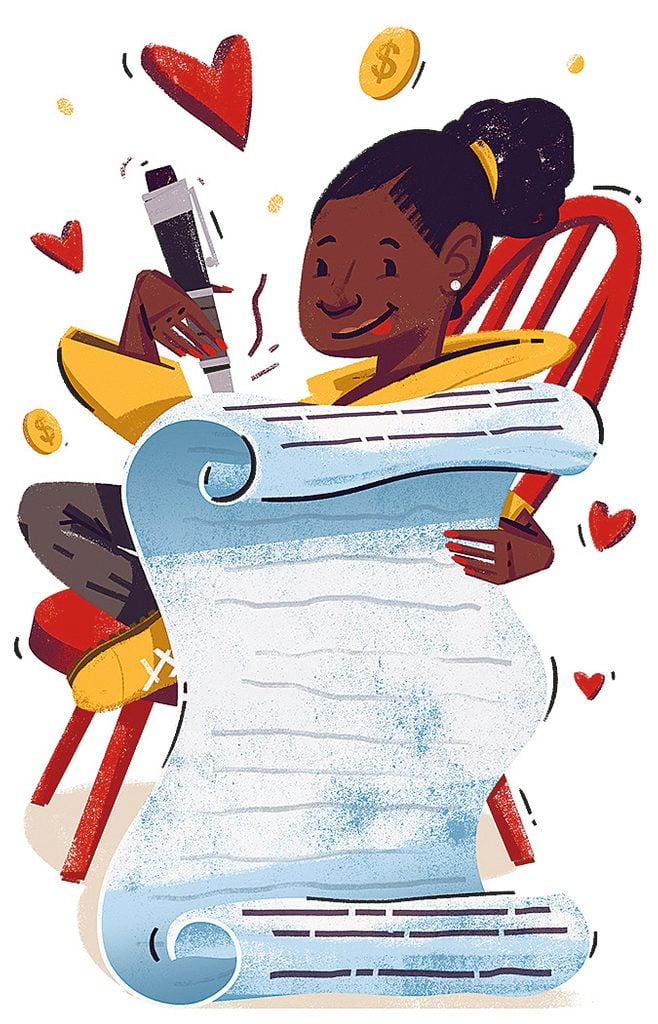
Fresh Start Recovery Centre
Aimed at Albertans grappling with addiction and homelessness, Calgary’s Fresh Start Recovery Centre provides an intensive four-month live-in program that includes fitness training, meditation and nutritional support. The group also provides counselling for family members, transitional housing for those recovering from alcohol use disorder and resources for employers. Other initiatives include a food truck that’s fully staffed by people in recovery; in 2020, it pivoted to bringing necessary supplies to those in need.
First Book Canada
COVID-19 has negatively impacted children’s education—and for some, it’s nearing a crisis. First Book Canada operates on the premise that “Education is a child’s best path out of poverty, but access to quality education is not equal.” The organization has connected kids in low-income households across the country with more than seven million books and educational resources.
Encampment Support Network
In Toronto, COVID-19 only increased the need for affordable housing—more than 100,000 households are now on waiting lists. The pandemic also highlighted the vulnerability of homeless populations, many of whom resorted to setting up encampments in parks. This volunteer network works tirelessly to deliver basic supplies, such as water, tents, ice, sleeping bags, fire-safety equipment and snacks, to those in need.
Educational Program Innovations Charity (EPIC)
Youth living in poverty or in at-risk situations, as well as members of Black and Indigenous communities, get support from this Sydney, N.S. organization, including one-on-one mentoring, parenting workshops and scholarships for high-school graduates. The program also helps kids from underprivileged families who struggle to get access to tech devices and Internet services.
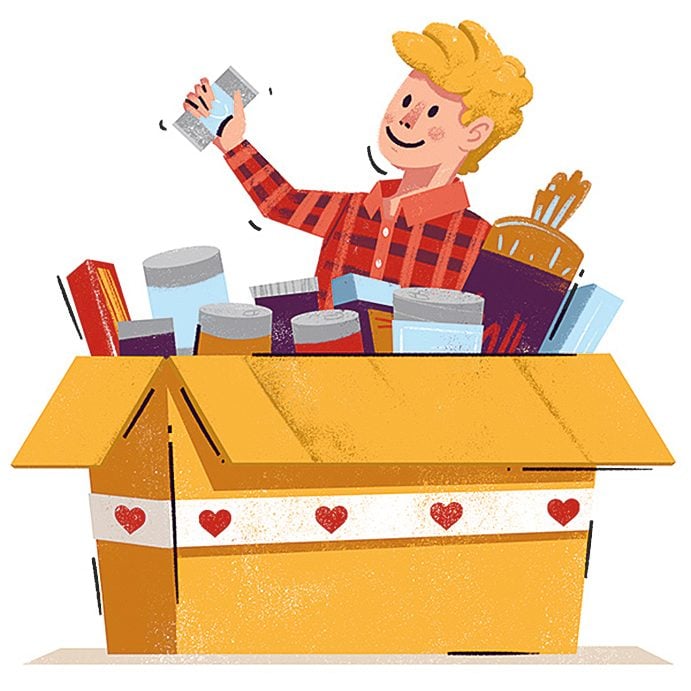
Indigenous Peoples Solidarity Fund
If you’re drawn to an issue, such as supporting First Nations communities, but you can’t narrow down your choices to an individual charity, CanadaHelps recommends more than 200 options in the First Nations category and 300 options in the Indigenous Peoples category. You may also choose to donate to the Indigenous Peoples Solidarity Fund, the proceeds of which are distributed between more than 40 Indigenous-led charities across the country, all of which were selected in consultation with an Indigenous adviser.
CUPS
CUPS is a Calgary community centre, health-care system and social-service agency rolled into one hub. Many programs are tailored to families, including several parenting workshops. In 2020 alone, CUPS saw 2,336 people use its services for the first time. During the pandemic, it created “assisted self-isolation sites” at a designated hotel for people with no fixed address who had been exposed to COVID-19.
Aunt Leah’s Place
For more than 30 years, New Westminster, BC’s Aunt Leah’s has prepared youth in foster care to live independently. They offer outreach programs, life-skills lessons and employment and educational guidance so youth can avoid becoming homeless when they’re compelled to leave their foster residences. The group also connects young people with housing and helps keep mothers in need from losing custody of their children.
Alison McAteer House, Sutherland House
People in the North can be particularly vulnerable to intimate-partner violence: isolation, the cost of living and the strain of small communities can all exacerbate volatile situations. And yet, according to a 2020 CBC News report, one out of every three people in the Territories are more than 100 kilometres away from a domestic-violence shelter. The cost of maintaining such lifelines is a huge obstacle, which is why every donation to these Yellowknife and Fort Smith shelters counts.
Black Lives Matter Canada
This umbrella organization provides a centralized pool to support Black Lives Matter groups across the country. This year, BLM Canada secured a bricks-and-mortar space in Toronto, the Wildseed Centre for Art & Activism, an industrial building that will serve as a performance area, cultural incubator and headquarters to nurture fellowships for Black artists.
#Elimin8Hate
This innovative Vancouver group aims to combat anti-Asian racism using creative strategies that range from interactive social-media campaigns to tools for educators. The organization also serves as a vital platform: members of Asian communities who experience racially motivated violence can report what happened, contributing to a data set that’s sadly ever-expanding.
For more inspiring stories of people making a difference in their communities, check out this roundup of good news from around the world.
My collection of watches is very personal, because of the history and memories associated with the various pieces. The pocket watch on the stand in this photo is now more than 100 years old and belonged to my grandfather, who died in 1961. As I’ve been told many times over the years, Grandpa had this watch with him in the trenches of Europe during the First World War.
My grandmother’s watch (at left in photo) was with her for as long as I can remember, until her death in 1977. I was fortunate to be able to use Grandma’s watch for a number of years after her death. What an honour!
The timepiece with the heart-shaped face was a Christmas gift from my grandparents in 1960. I was ten years old and I have treasured it ever since!
The watch at the far right belonged to Dad; he had it with him up until his death in February 2018. I’m showing my age, aren’t I, but I will cherish these watches always. They span such a large amount of time in our family’s history and will certainly be passed down to my daughter and granddaughters. Such an amazing legacy!
Next, check out more quirky collections across Canada.
In the 1950s like most Canadian boys, winter weekends for me meant hockey—on the street, the rinks (both indoor and neighbourhood ponds) or one of those Eagle brand table-hockey games on the rare days when the weather kept us indoors. Our small Grey County, Ont., town was no different.
For me, the added emphasis about the importance of being a good-on-the-ice Canuck kid was the fact that my father was a community leader who helped organize weekly games at the local rink. In my mind, there was a feeling of added concern to be rather good at our national game, although my parents never stated anything of the sort directly. I was, however, still filled with apprehension…wondering if I could bring my respectable road hockey game to real ice inside the spanking new Durham Arena. We received a new rink thanks to the local service clubs—including dad’s Kinsmen Club colleagues—who raised enough money through dozens of bingo nights and other local fund raisers to help build a better arena for our small community.

For the youngest residents, the town’s hockey organizers even divided the town of Durham (population of about 2,000…both then and now) into four quadrants. The northern quarter was designated as the Chicago Blackhawks, the west and east neighbourhoods were the Boston Bruins and Toronto Maple Leafs respectively, while the streets in the south, where we lived, were the Montreal Canadiens. Obviously, jersey sizes for these four pre-peewee team members were very small, befitting the six-to-eight-year olds who played in this “squirt” hockey league. The teams were comprised of only boys, as not many girls aspired to hockey glory in that era.
In the fall of 1950, a few months after my sixth birthday, it was time to join the south-end team—the Montreal Canadiens wannabees—who had some veteran players aged seven or eight. Several new tryouts were six, like me. I say try- out, but of course everyone made the team simply by showing up. My dad watched silently on the sidelines on that November morning as I skated up and down the left wing. I say skated but more accurately, it would be best described as scraping along with both ankles angled dramatically inwards, close to the ice surface—often fully touching the bottom at times! The memory of that very first on-ice experience is still fresh. As is my honest response to the innocent question my wonderful mother asked after I returned home. That same straightforward reply from a six-year-old in the winter of 1950 has been repeated many times at family gatherings, especially during the hockey season. Mom voiced what every caring parent would ask a son, or daughter, then or now:
“So, John, how did you do today on your first day on the team?”
“Okay, Mom, I know I could have done better wearing my rubber boots, but they made me wear skates!”
To my surprise, her question and my response both made the front page of our local weekly newspaper, the Durham Chronicle. Reporting local sports “news” was obviously important to my parents! Just like many other weekly papers in small-town Ontario, however, the Chronicle is a thing of the past. Today,
that two-line exchange would be shared in an email or Tweet.
Meeting a Legend
If you wanted further evidence of a child’s inherent honest reply to questions from adults of any status, you’ll be getting it soon! Just before my third week as a struggling squirt player, the town’s hockey organizers promoted their new arena by having the famous announcer—and Toronto Maple Leafs star—Howie Meeker speak at a pre-Christmas fundraising dinner.
Early the next morning, Howie visited players in the dressing room to encourage sportsman-like chats and to ask a few awestruck young kids a question or two. Sitting beside me was my proud father, the then president of the Kinsmen’s Club, as the man who introduced Howie the night before at their dinner event. Moving around the room, Mr. Meeker finally reached me, stopped and helped lace up one skate, before asking two perfect questions.
“Well young fellow, I sure know your dad, but what’s your name and what is your favourite NHL team?”

“I’m John Dickson, Mr. Meeker, and my favourite team is Montreal. They’re the best!”
My father chuckled quietly and Howie moved on rather quickly to the next nervous player on the bench. Dad finished lacing up my skates and, before I hit the ice (literally), he said, “Being honest is important son, keep doing that and have fun out there!”
I did, but my ankles never held me up, no matter how hard I tried. It was also embarrassing when I discovered the only way I could come to a complete stop on the ice was to cruise into the boards! Painful, even at my low speed.
The following summer, I moved on to the game of golf, a challenging sport that I still play to this day with our two grown sons. Odd…ice proved too slippery for them, too!
Next, check out these love letters to communities across Canada.
Not Your Typical “Coming to Canada” Story
My story is not your typical tale of coming to Canada. In fact, as I look back on it now, the whole experience seems extraordinary.
It feels like just yesterday that I landed here in Toronto on a spousal PR visa in the fall of 2004, with butterflies in my stomach and a glimmer of hope in my eyes to “make it big” here in Canada in my own way.
Twelve years down the line since arriving from India and counting, I am still proud to call Toronto my home away from home. This is the place where my loving husband Rajat and I were able to put a roof over our heads, where we had our child—our son Arjun—and where we made new friends. There was no looking back.
Or so I thought, because the story doesn’t end there.
Life is indeed full of surprises. There was a time, in the summer of 2011, when Rajat and I decided to move back home to India, to be closer to our respective families. We thought that it was time to assume our responsibilities towards our aging parents, give Arjun a childhood full of memories around his grandparents and cousins, and pass along values and a rich cultural heritage.
Once the decision was made, we wasted no time. We sold all of our prized possessions (for peanuts!) as if the world was ending tomorrow, packed our bags and said our final goodbyes to Toronto at Pearson International Airport.
After landing in Delhi, our birthplace, we experienced what you might call a honeymoon period, staying with my in-laws and enjoying a household full of maids, cooks and chauffeur-driven cars.
We were living the dream and then suddenly—boom—reality set in. We had our own bills to pay and expenses to meet; it was time to get on with our new life in India. After a determined search, my husband landed a job working for a well-known Indian software consulting company with an international clientele. Oftentimes life boils down to a matter of luck, or is it perhaps destiny?
As things turned out, Rajat’s new job was at a very senior management level, leading a large team of software and development professionals, and being the single point of contact for one of the company’s international banking clients. The client just so happened to be located in Canada‚—Toronto, to be precise. Almost as soon as he was hired, Rajat was on a plane to Toronto for his first client meeting.
Within ten months of having moved back to India, Rajat, Arjun and I were packing our bags to return to Toronto, due to the demands of my husband’s new job.
In August 2012, we touched down at Pearson with our suitcases in hands and a very funny feeling in our stomachs, finding it hard to believe that we were about to build a new life from scratch in Toronto, again.
Living in company-provided hotel accommodations for a month, we had 30 days to find a living space and get resettled as a family, which we did.
Fast-forward to the present: four years have passed since then, and we are back on our feet in our much-loved and twice-adopted hometown of Toronto. Indeed, life has come full circle for us.
Next, check out what coming to Canada was like in the 1920s.
To feel smooth and supple, the top layer of your skin—the stratum corneum—needs to be at least 10 per cent water. Any less than that, and your skin can’t properly shed the outer cells. That buildup causes cracks and flakes to form, leaving your skin feeling dry, scaly and sometimes itchy. Use moisturizer and drink at least two litres of water per day for general hydration.
On top of your skin’s outer layer is the acid mantle, which includes a thin film of sebum—the oil naturally produced by your skin. Beneficial bacteria thrive here and act as a line of defense against harmful bacteria, but when your acid mantle is damaged—either through over-scrubbing or hand sanitizers—your skin is more vulnerable to dryness and irritation.
Since hot showers or baths can melt the sebum, the Canadian Dermatology Association recommends bathing with warm (not hot) water for no more than 10 minutes a day. While your acid mantle does repair itself within a day, repeated long-term damage can leave your skin chronically angry.
An inherited deficiency in the lipid matrix—the mortar that helps keep skin intact—is among the many environmental and genetic factors that bring about eczema. That condition, which affects 17 per cent of Canadians, causes itchy, red, scaly patches. Fish oil supplements and foods rich in omega-3 fats, like salmon, have been shown to reduce symptoms.
The complex web of capillaries and other blood vessels in the dermis allow your skin to be a window into your overall health. For instance, itching can be an early symptom of diabetes, caused by excess blood sugar and poor circulation. And liver problems, such as hepatitis C, can cause rashes from the buildup of toxins in the blood. Call your doctor if you notice unexplained skin changes.
Next, check out what to always do if you want to avoid dry skin in winter.
